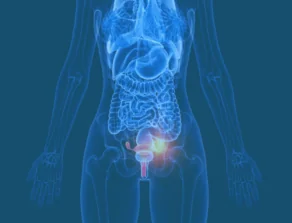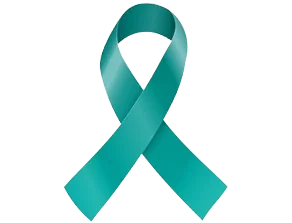Ovarian Cancer
About Ovarian Cancer
In the U.S., ovarian cancer ranks sixth in cancer deaths among women, accounting for more deaths than any other cancer of the female reproductive system.
Ovarian Cancer Key Facts
- An estimated 19,680 new cases of ovarian cancer will be diagnosed in the U.S. in 2024, with 12,740 deaths expected to result from the diagnosis.
- While all women are at risk of ovarian cancer, the overall lifetime risk of developing the disease is one in 87.
- The estimated five-year survival rate for patients whose ovarian cancer is detected early is about 92%. However, only 1 in 5 patients are diagnosed at the early stage.
- Ovarian cancer can be difficult to diagnose because initial symptoms are similar to gastrointestinal illness and indigestion. Women who experience symptoms daily for more than a few weeks should seek prompt medical evaluation.
Source: American Cancer Society’s Cancer Facts & Figures 2024 and the Society’s website

There is no known way to prevent ovarian cancer, but there are things that you can do to lower the chance of getting ovarian cancer:
- Having used birth control pills for five or more years
- Having given birth
- Breastfeeding
- Gynecologic surgery, such as tubal ligation and hysterectomy (only for medical reasons)
- A healthy lifestyle
For more information, visit How to Prevent Ovarian Cancer | Oral Contraceptives & Ovarian Cancer | American Cancer Society
If you have any of the symptoms below, it does not mean you have cancer but you should see your doctor or health care professional so that the cause can be found and treated, if needed.
Common symptoms
- Bloating
- Pelvic or abdominal (belly) pain
- Trouble eating or feeling full quickly
- Urinary symptoms such as urgency (always feeling like you have to go) or frequency (having to go often)
Other symptoms
- Fatigue (extreme tiredness)
- Upset stomach
- Back pain
- Pain during sex
- Constipation
- Changes in a woman’s period, such as heavier bleeding than normal or irregular bleeding
- Abdominal (belly) swelling with weight loss
Source: American Cancer Society’s website 2024
- Age – middle-aged or odder
- Obesity
- Genetic mutation, including BRCA1 or BRCA2, or associated with Lynch syndrome
- Have had/have a family history of breast, ovarian, urine, or colorectal (colon) cancer
- Have family cancer syndrome
- Hereditary breast and ovarian cancer syndrome (HBOC)
- Hereditary nonpolyposis colon cancer (HNPCC)
- Peutz-Jeghers syndrome
- MUTYH-associated polyposis
- Have never given birth or have had trouble getting pregnant
- Taking hormone therapy after menopause
- Using fertility treatment
- Smoking
Resource: Ovarian Cancer Risk Factors | Risk Factors for Ovarian Cancer | American Cancer Society
NFCR-Supported Researchers Working on Ovarian Cancer
Danny R. Welch, Ph.D.
University of Kansas Cancer Center
Wei Zhang, Ph.D.
Wake Forest Baptist Medical Center
Susan Band Horwitz, Ph.D.
Albert Einstein College of Medicine
Amos B. Smith III, Ph.D.
University of Pennsylvania
Robert C. Bast, Jr., M.D.
MD Anderson Cancer Center
Harold F. Dvorak, M.D.
Beth Israel Deaconess Medical Center

Ovarian Cancer Awareness Month is recognized in September.
Sign-up to Receive NFCR Emails
Be the first to learn about breakthroughs in cancer research and follow NFCR’s progress on making cures possible!
A world without cancer is possible. Help us turn lab breakthroughs into life-saving realities.

5.7 Million+
Donors who have fueled NFCR’s mission

$420 Million+
Invested in high-impact research & programs

36+ Labs & Hundreds of
Nobel Laureates & Key Scientists received NFCR funding, driving breakthrough research

















